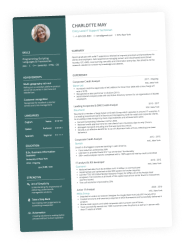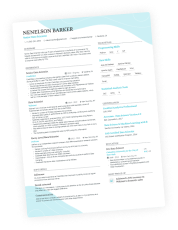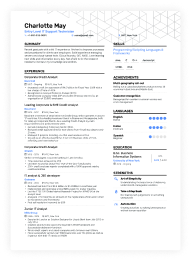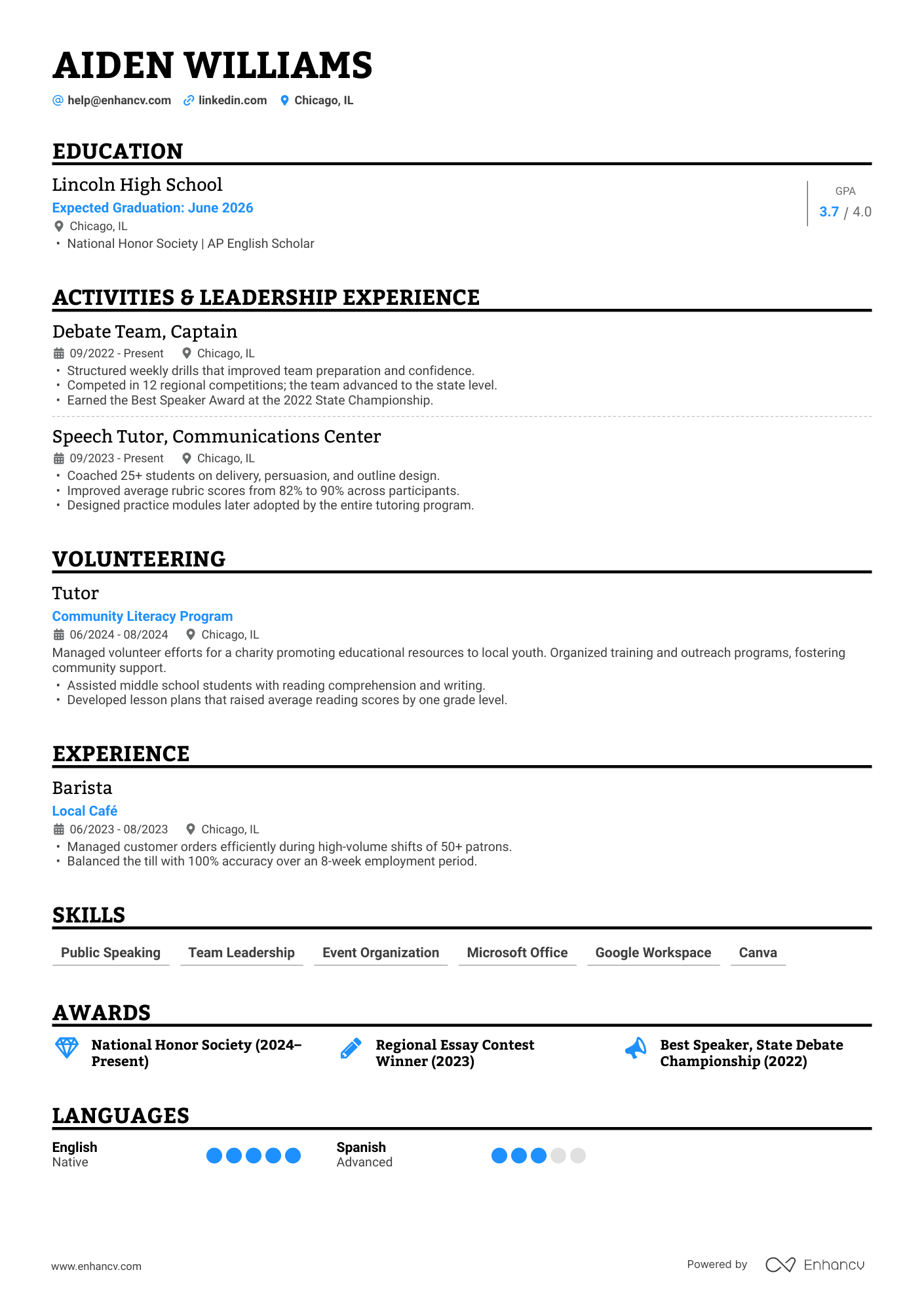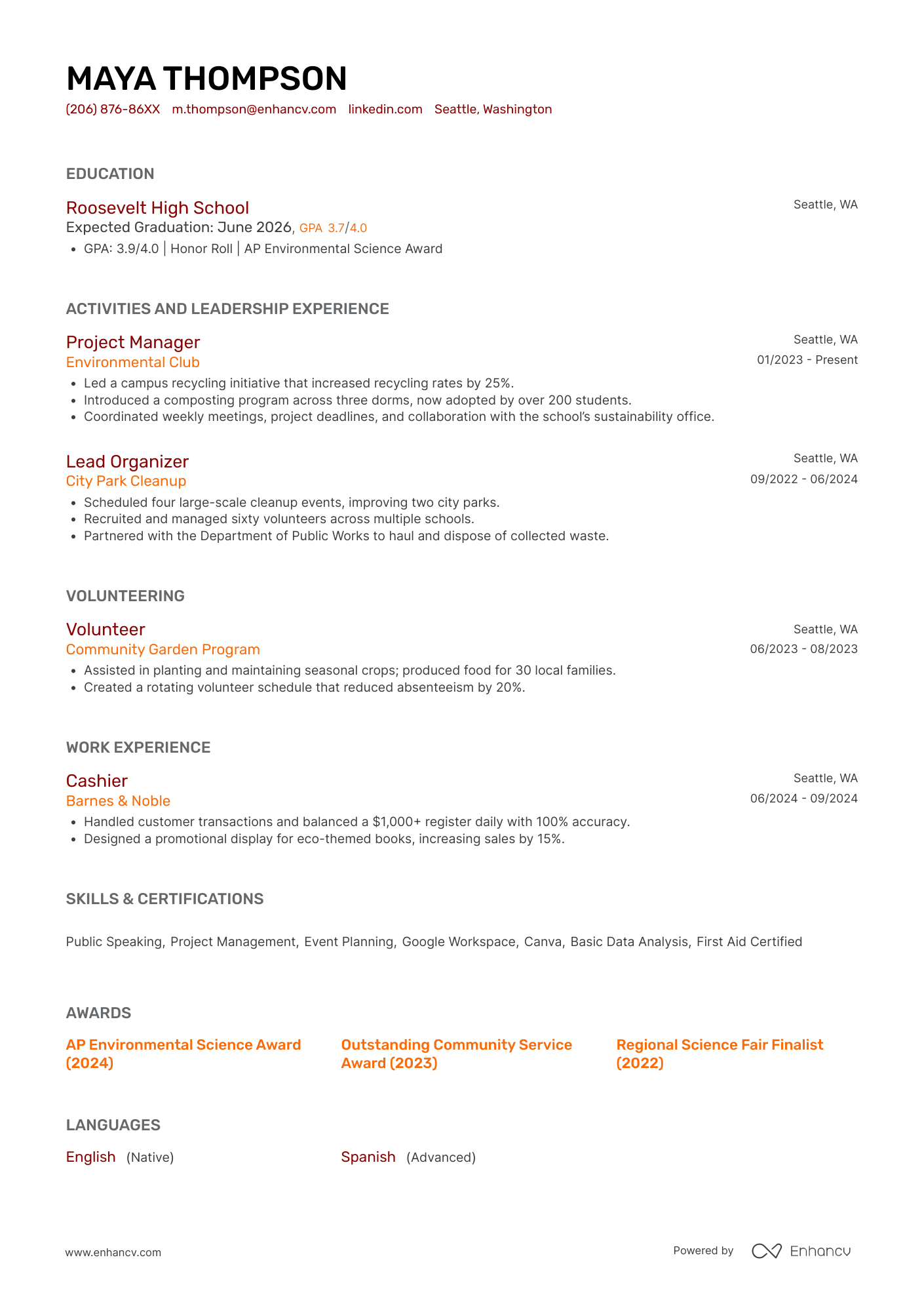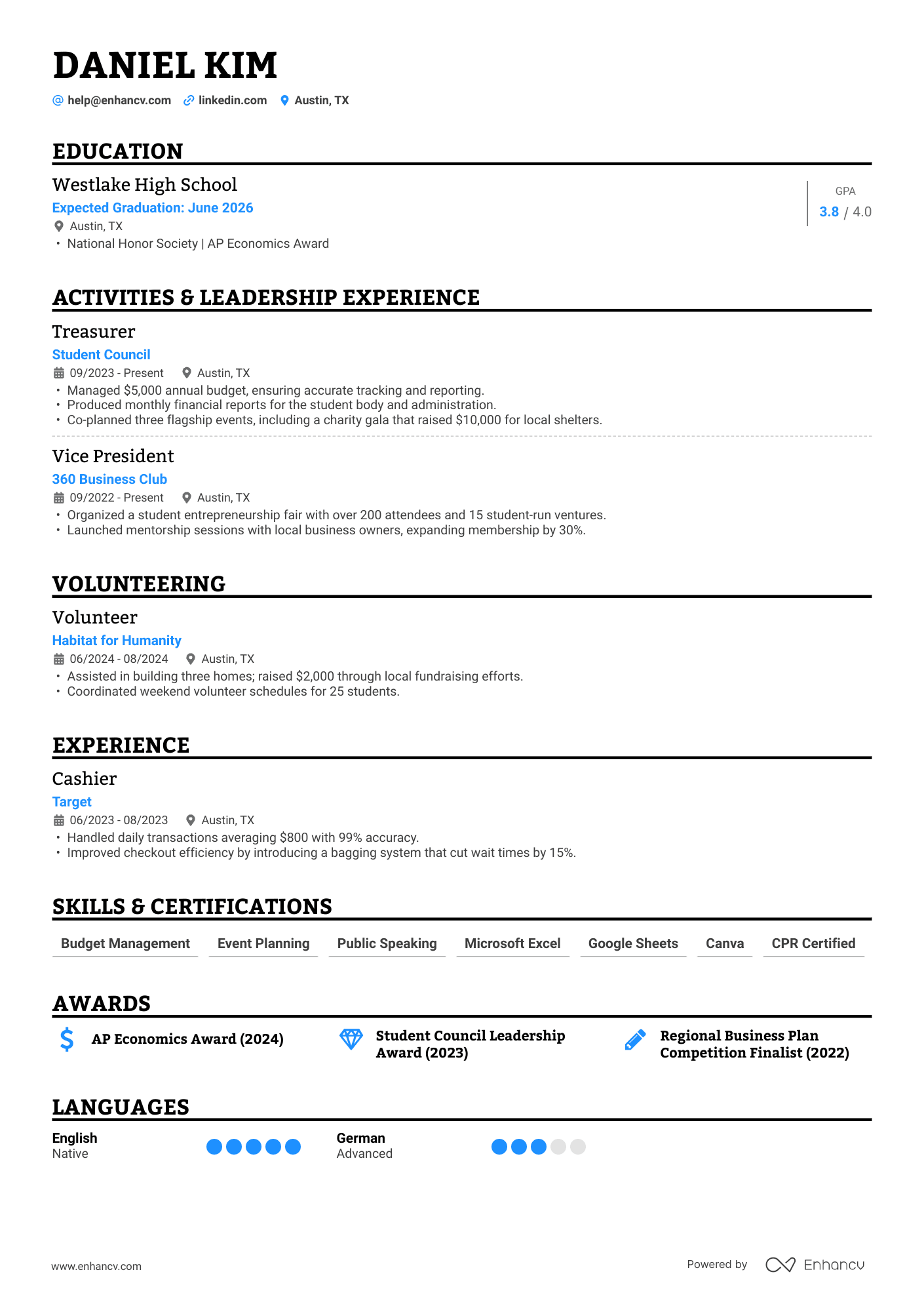An activities resume showcases who you are outside the classroom—your leadership, impact, and interests. Leading a robotics club, for instance, signals technical skill and the ability to manage a team and deliver projects.
Whether you're applying to college, scholarships, internships, or campus roles, a focused, quantified activities resume sets you apart. To present it cleanly, consider building with Enhancv’s free AI Resume Builder for a professional, polished result.
Key takeaways
- Choose activities that demonstrate leadership, teamwork, and initiative.
- Align entries to your intended major and long‑term career goals.
- Use a clean, skimmable format with consistent headings and bullet points.
- Lead bullets with action verbs and quantify results (numbers win attention).
- Prioritize quality over quantity—spotlight your most significant wins.
- Show growth over time—roles that progress from member to leader.
- Export and submit a PDF—proofread meticulously before sending.
What is an activities resume?
Before you can build one, it’s important to understand what makes an activities resume distinct from a traditional work resume.
Definition. An activities resume is a strategic snapshot of extracurriculars that highlights your roles, results, and skills beyond academics.
Unlike a traditional resume that centers on jobs, this document elevates clubs, teams, volunteering, competitions, and leadership roles. It gives admissions and hiring teams a well‑rounded view of you as a contributor and community member.
Fit to goals. Choose activities that reinforce your academic and career direction. Business applicants might emphasize student government, finance, or entrepreneurship clubs. An environmental science candidate could lead conservation projects or join fieldwork initiatives.
Format matters. Keep descriptions concise and outcomes specific. Use a clean structure, consistent verb tense, and clear section labeling. Enhancv’s templates can help you organize content that reads fast and looks polished.
With this foundation in place, the next step is deciding which activities deserve a spot.
Example of an activities resume for college
Jennifer Hunt
Boston, MA | j.hunt@email.com | (555) 123-4567 | linkedin.com
Education
Boston High School, Boston, MA
Expected graduation: June 2026
GPA: 3.8/4.0 | National Honor Society | AP Scholar with Distinction
Activities & Leadership Experience
Robotics Club, President | Boston, MA
Sep 2023–Present
- Led 18 members across 3 subteams—advanced to state championship for the first time in 5 years.
- Secured $3,500 in sponsorships—implemented project schedule, reducing rework by 20%.
- Mentored 6 new members, increasing retention and team engagement.
Debate Team, Treasurer | Boston, MA
Sep 2022–May 2024
- Managed $2,000 annual budget—funded travel to 4 regional tournaments.
- Competed in 12 tournaments—won “Best Speaker” at State Championships (2023).
Environmental Club, Project Manager | Boston, MA
Jan 2023–Present
- Designed and led campus recycling initiative, increasing diversion rates by 25%.
- Launched composting pilot program in 3 dorms—presented findings to the school board.
Charity 5K Run, Event Coordinator | Boston, MA
Mar 2024
- Organized 20 volunteers—attracted 300 participants—raised $5,000 for local charities.
Volunteer Work
City Hospital, Volunteer Coordinator | Boston, MA
Sep 2023–Present
- Scheduled 10 volunteers per shift—implemented bedside-manner training that boosted patient satisfaction by 15%.
- Digitized onboarding checklist, reducing schedule conflicts by 40%.
Food Bank of Boston, Volunteer | Boston, MA
Summer 2023
- Distributed meals to 150 families weekly—created a new inventory system that cut food waste by 10%.
Skills & Certifications
- Spanish (conversational) | Python (intermediate) | Google Workspace
- CPR and First Aid certified
Honors & Awards
- National Honor Society, 2024–Present
- AP Scholar with Distinction, 2024
- Robotics State Finalist, 2023
Structuring your activities resume
A strong activities resume isn’t just about what you include—it’s about how you organize it. Admissions officers and scholarship committees expect a layout that’s clear, professional, and easy to scan.
Here’s the structure most students use:
1. Header
- Name (larger font, bold)
- Contact information: email, phone, city/state, optional LinkedIn or portfolio link.
- Optional: one-line profile or headline (“High school senior passionate about robotics and community service”)
2. Education
- School name, city, state
- Graduation date (or expected date)
- GPA (if strong), honors, or awards
- Relevant coursework
3. Activities and Leadership Experience
This is your core section—for each activity:
- Organization: Role/Title, location
- Dates active (Month/Year–Month/Year or Present)
- Two to three bullets using action verbs + measurable results
PRO TIP
Subdivide if you have many entries: Leadership Roles, Clubs & Organizations, Community Service.
4. Volunteer Work
Same format as activities—focus on measurable contributions.
5. Work Experience (if applicable)
Part-time jobs, internships, or programs that show transferable skills.
6. Skills and Certifications
Languages, software, coding, or relevant certifications.
7. Honors and Awards
Scholarships, competitions, or special recognitions.
Best practices
- Keep it to one page (two if absolutely necessary).
- Use clear headings and bold role titles.
- Be consistent with tense and dates.
- Export as PDF to lock formatting.
Below, we’ll dive deeper into the activities themselves and how to craft them effectively for your resume.
Choosing the right activities to highlight
Not every activity deserves a spot on your resume, so think strategically about which experiences best show your initiative, leadership, and long-term goals. Let’s go through some particular activities and the advice they demonstrate.
Lead with leadership
Prioritize positions where you organized people, managed budgets, or executed events.
Robotics Club, President
- Designed and tested two competition-ready robots, placing in the top 10% statewide.
- Introduced a CAD-based prototyping workflow that cut design revisions by 25%.
- Trained members in troubleshooting and rapid repair, reducing downtime during competitions.
Align with your path
Curate activities relevant to the major or role you want.
Coastal Cleanup Volunteer
- Coordinated beach cleanups.
- Collected and sorted 500+ pounds of waste.
- Briefed 40 volunteers on safety and sorting protocols.
Athletics leadership counts
Athletics showcase leadership, discipline, and teamwork, especially when you take on roles that influence your peers and outcomes.
Varsity Soccer Team Captain
- Organized daily drills and practice schedules for 20 teammates, improving overall fitness test scores by 18%.
- Led the team to a regional championship win for the first time in 10 years.
- Mentored 5 underclassmen players, boosting retention and helping 2 earn starting positions.
Volunteer work matters
Service demonstrates initiative and community impact, especially when tied to your field.
Hospital Volunteer Coordinator
- Scheduled 10 volunteers per shift and introduced bedside‑manner micro‑trainings, raising patient satisfaction scores by 15%.
Unique or specialized experiences stand out
Niche competitions, research, or long‑term passion projects can differentiate you.
National Robotics Competitor
- Contributed to drivetrain redesign, helping our team advance to nationals for the first time in 5 years.
Spotlight transferable skills
Communication, teamwork, problem‑solving, and project management should be obvious in your bullets.
Debate Team Captain
- Built a weekly practice curriculum and coached rebuttal techniques, helping the team place in the top 10% statewide.
Once you’ve narrowed down the right activities, the real advantage comes from tailoring them to your major and career path.
Tailoring your activities to your major and career goals
The most impactful resumes connect extracurriculars directly to your academic focus or intended profession. This shows reviewers that you’re already thinking like a future student or professional in the field.
Pre‑med
Show patient-facing experience, teamwork in high‑pressure settings, and scientific curiosity.
- Hospital or clinic volunteering (patient transport, triage support).
- Research assistant roles (IRB‑approved studies, data collection).
- Pre‑health club leadership and community health initiatives.
Business
Emphasize leadership, budget ownership, and entrepreneurial execution.
- Student business club treasurer/president (budgeting, sponsorships).
- Startup or side venture (basic P&L, customer discovery, marketing).
- Case competitions and student government finance committees.
Engineering/CS
Demonstrate technical build work and collaborative problem‑solving.
- Robotics, coding clubs, hackathons, and engineering competitions.
- Project portfolios (apps, circuits, prototypes) and peer mentorship.
Example:
“Launched a Python track, with 15 students completing a group project that won a regional competition.”
Marketing/Communications
Highlight campaigns, content, events, and measurable reach.
- Social media management (growth metrics), event promotion, PR.
- Journalism or debate (storytelling, persuasion, research).
Environmental science
Field projects, conservation outcomes, and policy advocacy.
- Campus recycling initiatives, habitat restoration, and policy clubs.
Example:
“Increased campus recycling by 25% and launched a composting program adopted by 3 dorms.”
Rule of thumb
If an activity strengthens your case for your target program or role, it belongs—and should be quantified.
After selecting activities that align with your academic and career goals, the next step is learning how to format and present them effectively on your resume.
How to list activities on a resume
Structure each entry for fast scanning:
1. Section title: Use “Leadership & Activities,” “Extracurricular Activities,” or “Activities.”
2. Each entry includes:
- Organization: Role/Title, location
- Dates: Month/year–month/year (or present)
- Bullets (two to four): Action + task + metric + outcome
3. Formatting and style:
- Use the present tense for current roles and the past tense for completed ones.
- Best to keep them in a reverse-chronological order format.
- Keep bullet points to one line when possible—lead with strong action verbs (see list below).
- Quantify scope (teams, budgets, attendees, dollars, reach, time saved).
Sample entry
City Hospital, Volunteer Coordinator | Springfield, IL
Sep 2023–Present
- Recruited, trained, and supervised 12 volunteers per shift, increasing retention by 25%.
- Developed a recognition program that improved volunteer engagement scores.
- Created a digital handbook to streamline orientation and reduce onboarding time by 30%.
Action‑verb mini‑library
- Led
- Organized
- Launched
- Built
- Coordinated
- Spearheaded
- Analyzed
- Optimized
- Mentored
- Partnered
- Delivered
- Secured
- Raised
- Streamlined
- Improved
Once your entries follow this pattern, quantify outcomes to turn duties into demonstrable impact.
Quantifying your impact in extracurriculars
Numbers, percentages, and measurable outcomes turn a generic activity list into a persuasive record of accomplishment.
Why numbers? Metrics translate effort into evidence. They make your value legible at a glance.
Use scope + action + result
Event Coordinator, Charity Run
- Organized 20 volunteers and attracted 300 participants, raising $5,000 for local charities.
Coding Club
- Spearheaded a Python initiative in which 15 students completed a capstone project that went on to win regional honors.
Debate Club, Treasurer
- Managed a $2,000 budget and reconciled expenses monthly, funding travel to four tournaments on plan.
Show growth over time
“Environmental Club,Member → Lead → Project Manager — Increased recycling 25% by launching a compost program now adopted dorm‑wide.”
PRO TIP
If you lack hard numbers, estimate responsibly: “Supported 8–10 patients per shift,” “Wrote 6–8 weekly social posts,” or “Trained 5 new members each semester.”
To ensure those quantified achievements get noticed, they must be presented in a clean and professional format.
When and how to submit an activities resume
Knowing the right moment to include your activities resume—whether for college, scholarships, or internships—ensures your efforts don’t go unnoticed.
When to include it
- With college applications (adds breadth beyond the application form).
- For scholarships (leadership and service matter).
- For campus clubs and internships (shows current, relevant experience).
How to submit it
- File type: PDF is safest for consistent formatting.
- Online portals: Upload alongside your application or as supplemental material.
- In person: Bring printed copies to interviews or campus visits to guide discussion.
Last step
Proofread line by line. Run spell‑check, read aloud, and ask a mentor to review. Even minor errors can undercut strong achievements.
Submitting is only part of the process—avoiding common mistakes will keep your resume polished and credible.
How an activities resume complements the Common App
The Common App lets you list up to ten extracurriculars, but space is tight—each entry is capped at 150 characters. That’s barely enough to say what you did, let alone the impact you made.
An activities resume gives you room to expand. Instead of writing “Debate Team Captain—led practices,” you can show how you organized weekly drills, competed in 12 regional tournaments, and won Best Speaker at State. This level of detail helps admissions officers see your initiative and results, not just your title.
PRO TIP
Use your activities resume to highlight what the Common App can’t fit—numbers, growth, and context. Titles alone don’t stand out; impact does.
Whenever possible, upload your activities resume as supplemental material or bring it to interviews. It reinforces your Common App entries with real context and measurable achievements.
Common mistakes to avoid when listing activities
Many students weaken their resumes by overloading them, leaving descriptions vague, or failing to match activities with their goals.
Stay away from the following:
- Overloading the page: A long, unfocused list dilutes your best work. Curate your most relevant activities.
- Vague descriptions: “Member” says little. Instead: “Active member who competed in 12 regional competitions and earned Best Speaker (2022).”
- Date discrepancies: Ensure dates align with your academic calendar and don't conflict.
- Generic templates: Avoid boilerplate bullets like “Responsible for tasks.” Be specific: what you owned, how you did it, and the outcome.
Quick reference: do/don’t table
| DO | DON’T |
|---|---|
| Lead with impact and metrics. | List duties without results. |
| Order by relevance to goals. | Bury key activities in the middle. |
| Use 2–4 tight bullets per entry. | Write paragraphs under each role. |
| Keep tense and dates consistent. | Mix formats (e.g., 09/23 vs. Sept 2023). |
| Export to PDF and test readability. | Submit unproofed drafts. |
Steering clear of these mistakes positions you to wrap up your activities resume with confidence and clarity.
What if you don’t have many activities?
Not every student has a long list of clubs or leadership roles—and that’s okay. Colleges are looking for evidence of drive and growth, not a packed schedule.
If your list feels short, highlight the quality of what you do have. A part-time job, caring for siblings, or helping in a family business can demonstrate responsibility just as much as a school club. Even personal projects—like starting a blog, building an app, or organizing a neighborhood cleanup—count as activities when framed with impact and outcomes.
Here’s an example that shows how even family responsibilities can count.
Babysitting or Family Caregiver
- Managed daily routines for 2 younger siblings, balancing school schedules, meals, and homework help.
- Built organizational systems that kept the household on track during parents’ work hours.
- Developed patience, time management, and leadership skills transferable to academic and extracurricular settings.
The key is to show what you learned, how you contributed, and why it matters. A few strong, well-described activities will always outweigh a dozen vague ones.
More examples of activity resumes
A solid template ensures logic, consistency, and visual clarity—so your achievements shine.
Enhancv offers customizable activities resume layouts tailored for admissions or internships. Add your activities and let the structure guide prominence and spacing.
College‑bound example (communication + debate):
High school leadership example (environmental impact):
Fundraising example (finance + operations):
Sample Leadership & Activities entries
Robotics Club, President | Austin, TX
Sep 2023–Present
- Expanded club membership from 12 to 20 by launching outreach to local middle schools.
- Organized robotics workshops for 50+ students in the community, promoting STEM education.
- Secured $3,500 in sponsorships and formed partnerships with local tech companies.
City Hospital, Volunteer Coordinator | Austin, TX
Sep 2023–Present
- Oversaw daily scheduling for 15 volunteers across multiple departments, minimizing coverage gaps.
- Partnered with local nursing schools to expand the volunteer pipeline by 20%.
- Implemented a digital shift-tracking system that cut scheduling conflicts by 40%.
Environmental Club, Project Manager | Austin Community College
Jan 2023–May 2024
- Increased campus recycling by 25% by launching a composting pilot in 3 dorms.
- Built a data dashboard tracking diversion rates and presented it to facilities.
Debate Club, Treasurer | Austin, TX
Sep 2022–May 2024
- Launched sponsorship outreach campaign, securing $1,200 in donations to offset competition costs.
- Coordinated travel logistics and accommodations for four tournaments, ensuring events stayed within budget.
Charity 5K Run, Event Coordinator | Dallas, TX
Mar 2024
- Coordinated race logistics, including registration, route setup, and safety checks for 300 runners.
- Partnered with three local businesses to sponsor the event, contributing to $5,000 raised for charity.
Frequently asked questions about activity resumes
To wrap things up, here are answers to some of the most common questions students have about activity resumes.
Q. How many activities should I include?
A. Five to ten strong entries are typical—prioritize those most relevant to your goals.
Q. Can I include interests and hobbies?
A. Yes—if they show dedication or relevant skills (e.g., open‑source contributions, competitive chess).
Q. Where do I put my GPA and coursework?
A. In your “Education” section. Keep activities focused on roles and results.
Q. What if I lack leadership titles?
A. Show leadership behaviors: mentoring, training, coordinating shifts, or owning a deliverable with measurable outcomes.
Q. Do certificates or competitions belong here?
A. Yes—use a separate “Awards & Honors” section or integrate into the relevant activity with the result.
Stop treating your activities resume like a grocery list. Admissions officers don’t care that you ‘attended meeting’ or ‘helped out.’ They want to see sparks of initiative—moments where you've made something happen, even if it’s small. A resume full of passive participation is forgettable—one that shows you driving change is magnetic.
Writer’s take
Conclusion
A compelling activities resume combines relevance, leadership, and measurable impact—presented in a clean, scannable resume format. Curate strategically, quantify results, and show how your experiences connect to your next step.
Ready to turn this into a standout document? Build it with Enhancv’s free AI Resume Builder to structure your section, tighten bullets, and export a professional PDF in minutes. Your future self—and your reviewers—will thank you.
Make one that's truly you.

